Socrates said: Man, know yourself!
"Know thyself!" - This is a famous maxim engraved on the Temple of Delphi , the holy city of Greece . Ancient Greek and later philosophers liked to quote it to admonish the world.
This proverb has three profound meanings: people should have self-knowledge; the secret of human nature is hidden in everyone, and human nature can be understood by understanding oneself; everyone is a unique individual, and should recognize their own unique gifts and values, so as to achieve self-realization and truly become themselves.
Understanding human nature by knowing oneself is a shortcut . In daily work and life, many people do not understand their real needs, do not know what kind of work they are suitable for, and do not know how to manage themselves. These are all manifestations of not understanding themselves.
How do you know yourself? This article shares 7 effective methods to help you analyze and understand yourself from different perspectives, so that you are no longer in a state of confusion.
Maslow's hierarchy of needs . It is one of the important theories in psychology, which advocates that human beings need to continuously meet their needs according to the hierarchy in order to achieve the goal of self-realization and gain happiness and success.
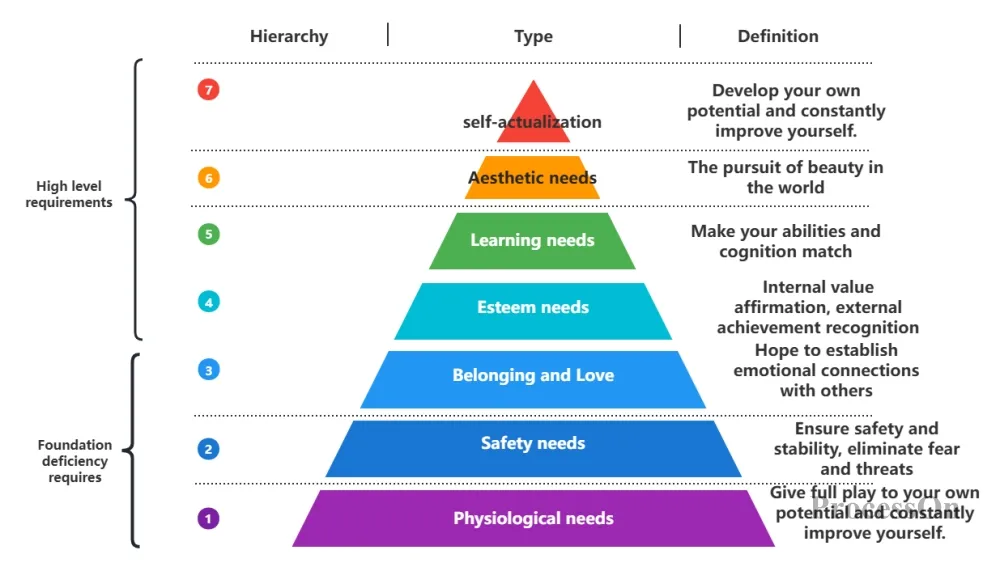
There is controversy over whether Maslow's need theory should be divided into five or seven levels . From the perspective of the completeness of the theoretical explanation, the seven-level theory is more comprehensive. In the five-level theory, Maslow divides human needs into physiological, safety, social, respect and self-actualization, while in the seven-level theory, the newly added cognitive and aesthetic needs can better explain the level of human needs and more comprehensively reflect the structure of human needs.
This theory starts from the basic physiological needs of human beings and gradually moves upwards. Only when the low-level needs are met can we have the motivation to achieve high-level needs and thus improve the level of life. We can meet these seven levels of needs step by step according to our own situation, improve our self-worth, and thus achieve happiness and success.
Maslow's hierarchy of needs theory can be used for self-awareness, and is also applicable to scenarios such as life planning, team management, and parent-child education.
The Dunning-Kruger Effect, also known as the Dunning-Kruger Effect, is a cognitive bias proposed by psychologists David Dunning and Justin Kruger of Cornell University in the United States in 1999. This effect describes that people with insufficient abilities tend to overestimate their abilities, immerse themselves in the illusory advantages they create, but are unable to objectively evaluate the abilities of others, while people with strong abilities often underestimate their abilities.
The Dunning-Kruger effect reveals common biases in people's assessment of their own abilities and emphasizes the importance of metacognitive abilities .
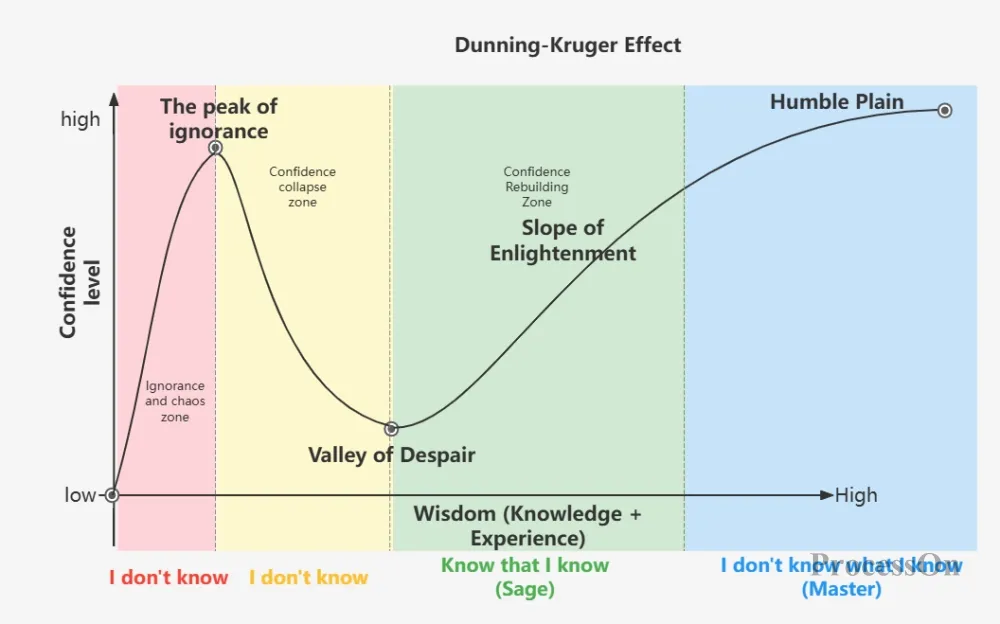
to cure a person's illness ? When he doesn't think he is sick. When is it the hardest to improve himself? When he thinks he is good enough.
When a person realizes his own shortcomings , he can stimulate himself to start studying hard. Then he should proceed step by step, integrate such stimulating habits into all aspects of life, become a companion of time, and thrive in the silent process.
Therefore, we can more accurately assess our abilities by improving our metacognitive abilities, receiving appropriate feedback, and continuing to learn , thereby achieving better results in personal and professional development. Don't let the Dunning-Kruger effect hinder your upward growth!
In this world, there is one path that cannot be chosen, and that is the path of giving up; there is one path that cannot be refused, and that is the path of growth. Growth is a process of bravely breaking the circle, and the growth breaking circle model is a methodology that helps individuals or organizations break through existing limitations and achieve higher-level development .
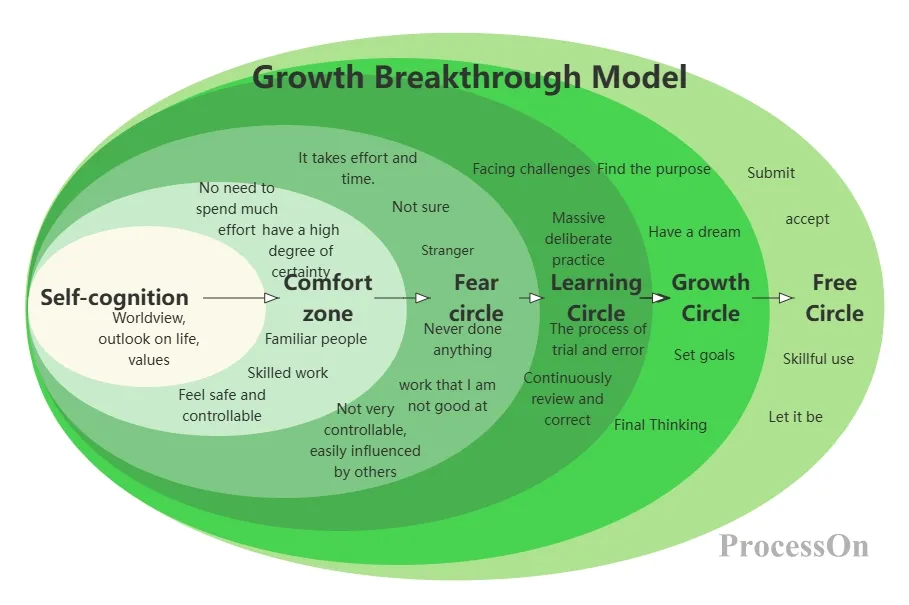
The growth breaking circle model has 6 layers, namely self-awareness circle, comfort circle, fear circle, learning circle, growth circle and freedom circle.
1. Self-awareness circle. What does the world look like in your eyes? What do you think is most important and valuable? What kind of person do you want to be in the future? Reasonable self-awareness is the beginning of breaking the circle and growing.
2. Comfort zone. In the comfort zone, we like to do familiar and repetitive things and lie down comfortably. It is both a need for belonging and a constraint in life. If you want to break out of your comfort zone, you can take stock of your strengths and ask yourself whether you are satisfied with your current life. If the answer is no, then you have the motivation and drive to break out of your comfort zone.
3. Fear circle. After entering the fear circle, facing unfamiliar and uncontrollable people and things, it is inevitable that you lack confidence, worry about gains and losses, blame others, and find excuses to retreat. If you want to overcome fear, you must have the courage to admit your problems, objectively analyze and sort out your worries and fears, and sort out your resources and connections.
4. Learning circle. The learning circle requires us to spend time to conquer new areas as soon as possible, dare to try and fail and accumulate experience from mistakes, master new skills through deliberate practice, learn to review and summarize, and improve learning efficiency.
5. Growth circle. Once we enter the growth circle, we are goal-driven. We need to work hard on ourselves and be result-oriented. By setting future goals, thinking about strategies, and integrating the resources needed for the implementation process, we are more mature and confident, our personal value is increasing rapidly, and we have core competitive advantages.
6. Freedom circle. To return to the freedom circle, we must learn to accept the objective facts that we cannot change, go all out but not care about gains and losses, learn to reset to zero and set new goals, and lifelong growth should be the long-term pursuit of life.
In a nutshell, personal growth is a process of breaking through the comfort zone, overcoming the fear zone, expanding the learning circle, upgrading the growth circle and returning to the freedom circle . Only by studying hard, self-reflecting and constantly practicing to break the existing comfort zone can we achieve continuous growth and progress.
The Personal Business Model Canvas is a variation of the Business Model Canvas, adapting a tool originally used for corporate business model design into a framework for personal career development and self-management. The Business Canvas was first proposed by Alexander Ostwald and Yves Pigneux in their book Business Model Generation , and the Personal Business Canvas builds on this concept and applies it to the personal level.
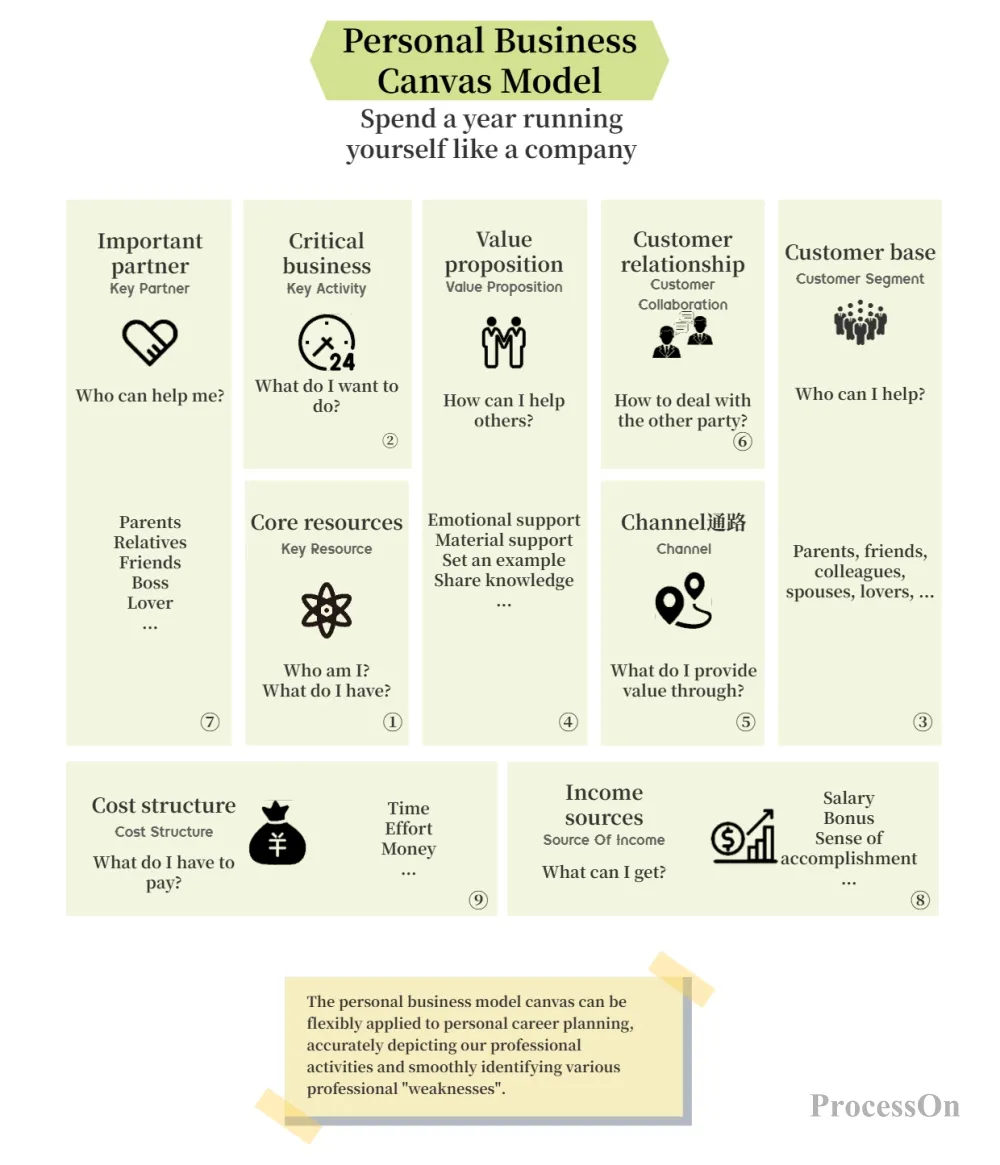
Personal Business Canvas Model
Running your life is like running a company, and the components of a personal business canvas often correspond to the nine building blocks of the business canvas.
1. Core resources : Who am I? What resources do I have?
Tangible resources: including your skills, knowledge, qualifications, etc.
Intangible resources: personal brand, network, reputation, etc.
2. Key business : What should I do?
Core Activities: List the key activities you need to carry out to achieve your value proposition, such as learning and improvement, project cooperation, resource integration, etc.
Partners: Describe the people or organizations you might need to work with to support your business development.
3. Customer group : Who can I create value for and help?
Target customers: Describe your target customer group, such as newcomers to the workplace, freelancers, entrepreneurs, etc.
Needs and pain points: List the main needs and pain points of these customers, such as improving professional skills, finding cooperation opportunities, obtaining entrepreneurial guidance , etc.
4. Value proposition : How do I create value and help others?
Unique selling point: Explain what unique value you can provide to customers, such as professional skills, rich experience, personal connections, etc.
Solution: Describe how you meet your customers’ needs and solve their pain points.
5. Channels : How to promote yourself or your products?
Promotion channels: List how you will promote yourself, such as social media, online platforms, offline events, etc.
6. Customer relations : How to deal with customers?
Describe how you stay connected with your customers, such as regular communication, building communities, providing after-sales services, etc.
7. Key Partners : Who can help me?
Whether it is a cooperative relationship, partnership or buying and selling relationship, ask yourself: How can I provide help and support?
8. Cost structure : What will I pay?
Fixed costs: such as learning and training costs, platform usage fees, etc.
Variable costs : Costs incurred based on project or business needs, such as investment in cooperative projects, marketing expenses, etc.
9. Source of income : What can I get?
Income channels: Describe your income sources, such as providing consulting services, participating in project collaborations, selling products, etc.
Pricing strategy : Set reasonable prices based on your value proposition and market demand.
The usage scenarios of the Personal Business Model Canvas include but are not limited to career planning, self-introduction, personal brand building, career transformation, network expansion and performance evaluation . It is a very flexible tool that you can customize and adjust according to your specific needs and goals.
The Iceberg Model is an important theory widely used in psychology, human resource management and cross-cultural communication . This model was proposed by American psychologist David McClelland in 1973 to describe the different levels of personal qualities. The Iceberg Model divides personal qualities into "the part above the iceberg" and "the part below the iceberg". The former are explicit, easy to observe and measure characteristics, while the latter are implicit, difficult to observe and measure characteristics.
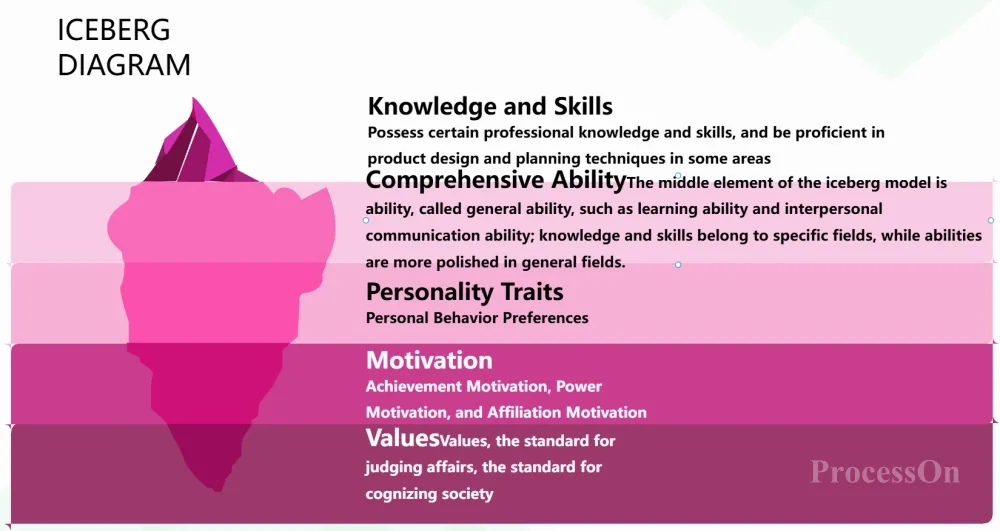
Generic Iceberg Model Template
Above the iceberg: 30%, including knowledge and skills. These are information that is easy to obtain and see, such as a person's education, major, experience, and skills, which can be changed through training and learning.
Below the iceberg: accounting for 70%, they are the individual's comprehensive ability (ability transfer can be achieved through self-cognition, self-reflection, and self-learning), personality traits, motivations, and values. These are the individual's unique subjective behavioral traits that are influenced by the long-term family, social, work and study environment, and are difficult to change.
We can use the iceberg model to do an in-depth analysis of ourselves. In addition to our knowledge and skills in a certain field, it is more important to ask ourselves what are our unique advantages? What would make us happy? What is our personality and values like? If we want to do something, is this a plus? In this way, we can deeply understand ourselves and find the development direction that suits us.
The life value Venn diagram is a practical tool that helps us clarify our life goals and achieve personal value and happiness.
This picture consists of four intertwined circles, representing passion, skills, money and value. Each circle represents an important aspect of life, and their intersection is the key to finding our ideal career and life value.
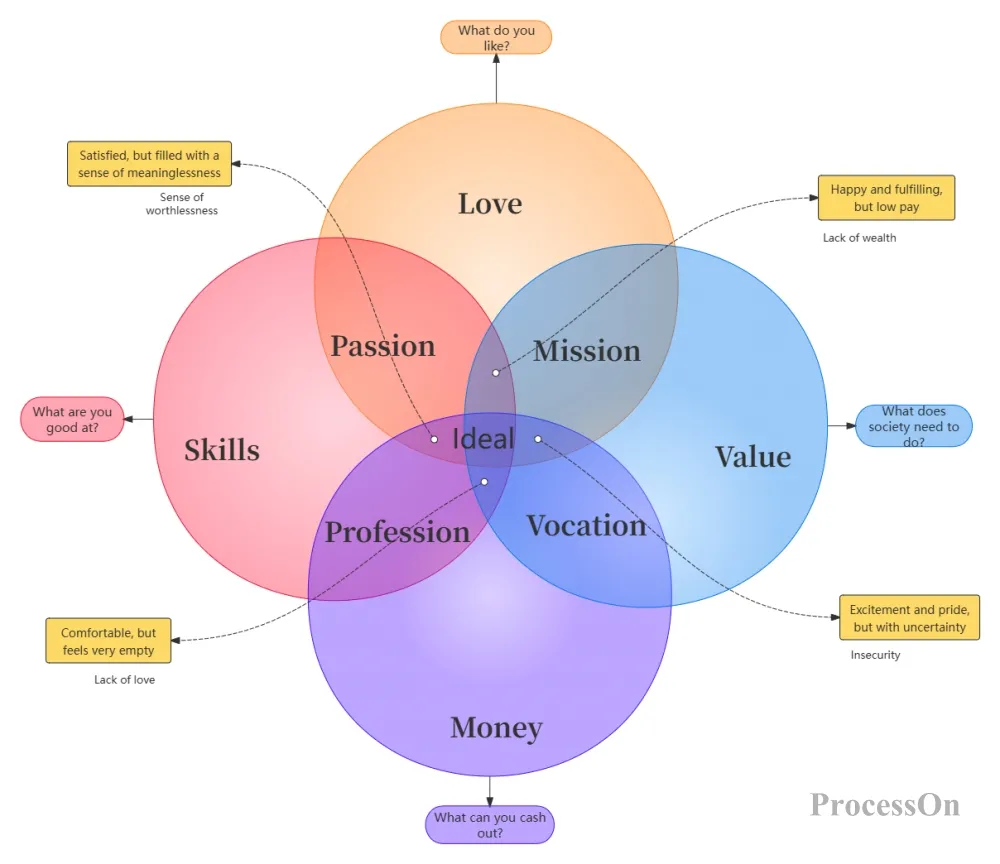
1. Love circle. It represents one's own interests and passions. Only by engaging in a career that we love can we devote ourselves to it and enjoy the happiness and satisfaction brought by the process.
2. Skill circle. It represents our talents and expertise. We can do things that are within our own strengths and abilities with ease and more easily achieve results.
3. Money Circle. This means that we need to consider the commercial viability and financial returns of our business. Although money is not the standard for measuring everything, it is indeed an important factor in achieving freedom and independence.
4. Value circle: Emphasize the value that the things we choose to do bring to others and society. Such choices are more likely to gain a sense of accomplishment and self-satisfaction.
By analyzing the relationship between these four circles, we can find a career that not only matches our passion and skills but also meets social needs. This career will become our goal, driving us to keep moving forward and realize our life value.
There is a saying, "A person who can change himself is a god, and a person who always wants to change others is a psychopath."
the Circle of Influence proposed by American scholar Stephen Covey in his best-selling book " The Seven Habits of Highly Effective People ".
Through this picture, we can clearly understand what we can control, what we need to care about, and what we must accept, thereby improving our control over our lives.
In reality, many of our worries and anxieties usually come from our excessive focus on things that we cannot control, while turning a deaf ear to things that we can control. The more we want to change others, the more likely we are to be disappointed, angry, and anxious, because we bet on people and things that we cannot control. This long-term accumulated sense of frustration and powerlessness will gradually make us lose control over our lives and our sense of happiness.
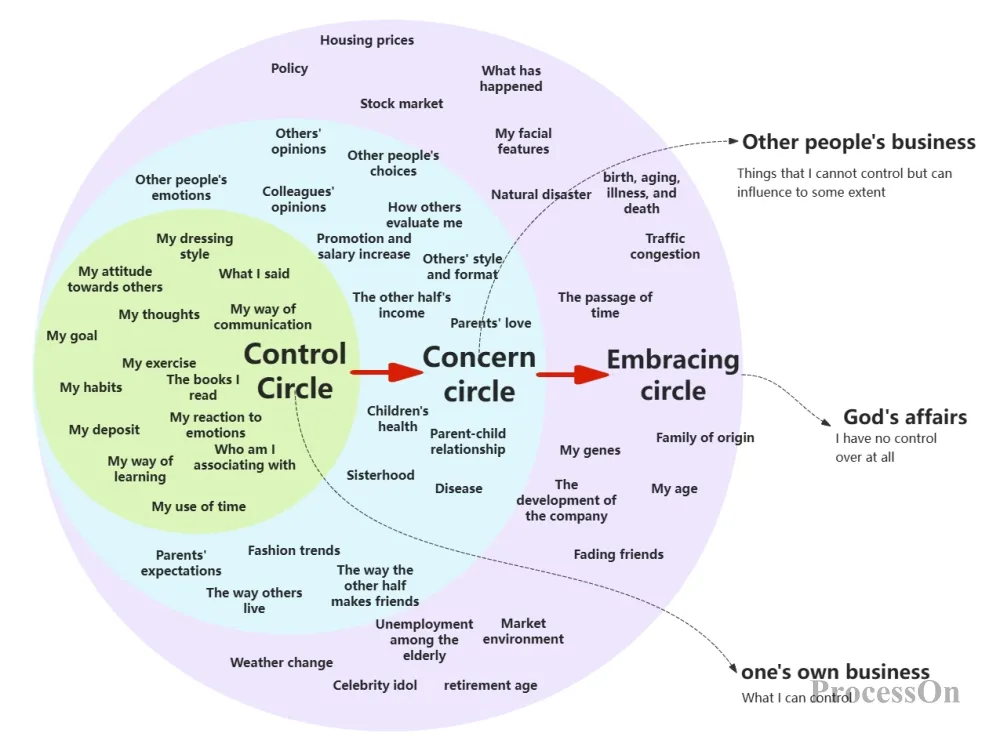
The Onion Model of Life Control
This life control chart divides things into three categories:
1. Your own affairs: circle of control. Matters are related to you and you can solve them by changing your behavior.
2. Other people’s affairs: Circle of Concern. Matters are related to others, and you can solve them by improving the way others influence you.
3. God’s business: Acceptance circle. For problems that are beyond personal control, do your best and leave the rest to God. Accept reality with a smile, calmness and a peaceful attitude.
If you want to dominate your own life, you have to make choices: take immediate action on "things I can control", do your best and leave the rest to fate on "things I can influence to a certain extent", and let go completely on "things I cannot control". Continuously expanding our circle of control, improving our sense of control, and making our core more stable, those internal frictions, anxieties, and uneasiness will gradually decrease, and we will gain a stronger sense of happiness and contentment.
Correctly understanding oneself is an important cornerstone of personal growth. By continuously improving our self-awareness, we can better understand ourselves, make more informed decisions, enhance our self-confidence, improve our interpersonal relationships, and ultimately achieve all-round personal development.
All templates in this article are from the ProcessOn template library. As a professional and powerful drawing tool, ProcessOn supports online editing of UML diagrams, flow charts, mind maps, organizational charts and other graphics. Users can create new content from scratch, or easily edit and modify existing drawing frameworks and templates. The operation is simple and easy to use.